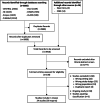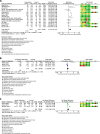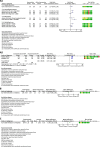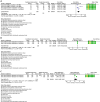Interventions to increase the uptake of cervical cancer screening in low- and middle-income countries: a systematic review and meta-analysis
- PMID: 36959632
- PMCID: PMC10035175
- DOI: 10.1186/s12905-023-02265-8
Interventions to increase the uptake of cervical cancer screening in low- and middle-income countries: a systematic review and meta-analysis
Abstract
Background: To identify effective interventions to increase the uptake of cervical cancer screening (CCS) for low-and middle-income countries (LMICs).
Methods: We searched PubMed, CENTRAL, ISI Web of Sciences, Scopus, OVID (Medline), CINAHL, LILACS, CNKI and OpenGrey for randomized controlled trials (RCTs) and cluster RCTs conducted in LMICs from January 2000 to September 2021. Two reviewers independently screened studies, extracted data, assessed risk of bias and certainty of evidence. Meta-analyses with random-effects models were conducted for data synthesis.
Results: We included 38 reports of 24 studies involving 318,423 participants from 15 RCTs and nine cluster RCTs. Single interventions may increase uptake of CCS when compared with control (RR 1.47, 95% CI 1.19 to 1.82). Self-sampling of Human Papillomavirus (HPV) testing may increase uptake of CCS relative to routine Visual Inspection with Acetic Acid (RR 1.93, 95% CI 1.66 to 2.25). Reminding with phone call may increase uptake of CCS than letter (RR 1.72, 95% CI 1.27 to 2.32) and SMS (RR 1.59, 95% CI 1.19 to 2.13). Sending 15 health messages may increase uptake of CCS relative to one SMS (RR 2.75, 95% CI 1.46 to 5.19). Free subsidized cost may increase uptake of CCS slightly than $0.66 subsidized cost (RR 1.60, 95% CI 1.10 to 2.33). Community based HPV test may increase uptake of CCS slightly in compared to hospital collected HPV (RR 1.67, 95% CI 1.53 to 1.82). The evidence is very uncertain about the effect of combined interventions on CCS uptake relative to single intervention (RR 2.20, 95% CI 1.54 to 3.14).
Conclusions: Single interventions including reminding with phone call, SMS, community self-sampling of HPV test, and free subsidized services may enhance CCS uptake. Combined interventions, including health education interventions and SMS plus e-voucher, may be better than single intervention. Due to low-certainty evidences, these findings should be applied cautiously.
Keywords: Cervical cancer screening; Low- and middle-income countries; Systematic review; Uptake.
© 2023. The Author(s).
Conflict of interest statement
The authors declare no competing interests.
Figures






References
-
- World Health Organization . Comprehensive cervical cancer control: a guide to essential practice. Geneva: Second edition; 2014. - PubMed
-
- GLOBOCAN. New Global Cancer Data. 2020. https://www.uicc.org/news/globocan-2020-new-global-cancer-data. Accessed 15 Mar 2020.
-
- World Health Organization. Global strategy to accelerate the elimination of cervical cancer as a public health problem and its associated goals and targets for the period 2020 – 2030. 2020.
-
- Brisson M, Kim JJ, Canfell K, Drolet M, Gingras G, Burger EA, et al. Impact of HPV vaccination and cervical screening on cervical cancer elimination: a comparative modelling analysis in 78 low-income and lower-middle-income countries. Lancet. 2020;395:575–590. doi: 10.1016/S0140-6736(20)30068-4. - DOI - PMC - PubMed
-
- Cervical screening: data and research - GOV.UK. https://www.gov.uk/government/collections/cervical-screening-programme-d.... Accessed 15 Mar 2020.

